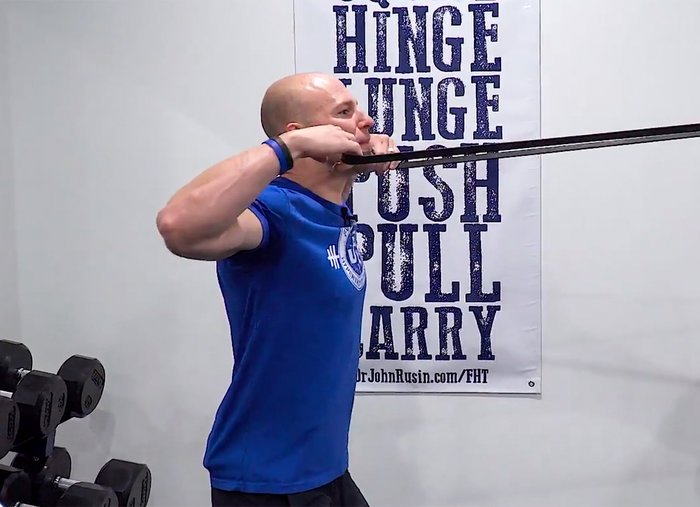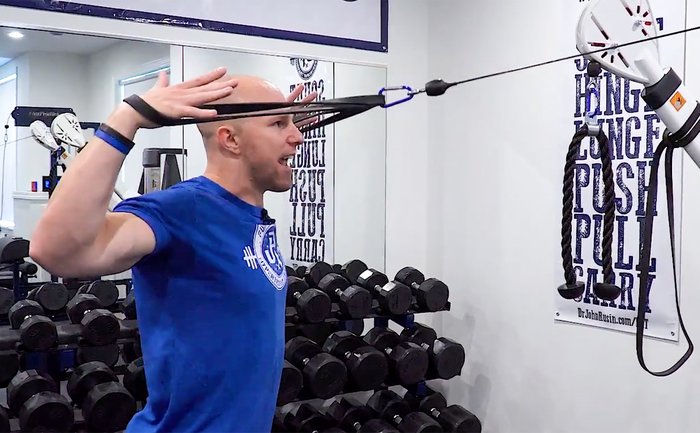It's safe to say I have a slight obsession with the face pull. Anyone familiar with my brand of hypertrophy training and programming knows this. But the truth is that I honestly believe them to be one of the biggest-bang-for-your-buck shoulder movements on earth.
Why so much love? Because over the last decade, I've seen the face pull prove itself over and over again to be the most effective direct shoulder training exercise in my programming arsenal. It builds big, strong, and stable shoulders and upper backs, while also helping to bulletproof the shoulders from chronic aches and pains in the process.
Honestly, those who can't benefit from this staple movement are few and far between. If you've been injured, it can be a game-changing component of rehab. If you're not injured, it's the perfect pre-hab, or just a way to prep your shoulders on a pressing day. And if you're someone who is trying to pull three times more than you push—the essential ratio for shoulder health—high-rep face pulls are the easiest way to get your numbers headed in the right direction.

So, what could possibly make it better? One simple change that you probably didn't see coming, but that you can do without having to buy any extra equipment other than a band (which, seriously, you should already have). After 18 months of beta testing this simple yet highly effective face-pull variation, I can definitively say this is the best variation that you've never done.
Check it out.
The Handless Banded Cable Face Pull
This variation is basically a combination of the best parts of the two most common face-pull variations: the banded face pull, and the cable rope face pull. I see both of these performed in the gym daily, and I program both of them in the Bodybuilding.com All Access guide Unstoppable: The Ultimate Guide to Training Through Injury. So, for anything to improve on either of them is a tall order!
One thing I love about the traditional banded face pull is that it offers more resistance at the tail end of the movement where the hands are close to the face, and less at the front side of the movement where many of the muscles of the upper back, including the posterior deltoid and teres group are weakest. This makes it ideal for warm-ups, but also for beginners, people coming back from injury, or anyone who doesn't have a lot of equipment.

The clear drawback to band-only face pulls is the inability to dial in the load exactly. That's where the cable face pull with rope attachment comes into play. When the goal is to train the face pull with more of a strength or hypertrophy emphasis, which I think is a great idea for long-term strength or muscle development, being able to nudge the weight up over time is a must.
However, as loading increases and efforts become heightened, it becomes harder and harder to avoid having to death grip the ropes. While there are plenty of movements where gripping the weight hard provides a benefit, the face pull isn't one of them. When you grip the rope hard, you initiate what's known as "the irradiation effect," transferring tension from the hands, up through the forearms, into the biceps and triceps, and finally into the shoulders and upper back.
As all of these muscle groups turn on, the movement becomes stronger as a whole, but it becomes less targeted on the small intrinsic muscles of the posterior shoulders. Those are what you're trying to strengthen with face pulls in the first place.

So here's the solution: Place a medium resistance circular band on the cable setup, looping each end of the band around your wrists. This way, you can take away the need for your hands to grip during the face-pull movement at all. This small change allows you to have more freedom of movement, giving you access to both internal and external shoulder rotation more that the more common rope setup would allow.
Another benefit? It keeps you seriously strict. One key drawback of rope cable face pulls is that you can lean against the weight with your body, allowing you to cheat the movement without even knowing it. But in the hands-free variation, the bands will pull and lengthen if the movement becomes too quick, forceful, or uncontrolled. This makes you dial in proper technique, constant tension, and muscular recruitment of the rear delts and upper back—and only those muscles.
How to Program It
With this setup, expect the loads you are used to using on the cable stack to be reduced by 25-50 percent right away. No, this isn't a bad thing.
Remember, a key tenet of pain-free training is maximizing muscular targeting while minimizing joint stress. By recruiting the right muscles and minimizing compensation from other muscles, you'll limit unnecessary stress on the wrist, elbow, shoulder joint, and spine, and put it squarely where it belongs.
Train this movement in the traditional hypertrophy rep scheme between 8-15 reps at minimum. You can also ride it all the way up to metabolic stress-based schemes that can exceed 50 repetitions.
As the weights get heavier for stronger lifters, two medium resistance bands, or a heavy single band, may be required. But that's a while down the road. To start, just enjoy the feeling of doing face pulls right, and your shoulders and upper back with thank you!
